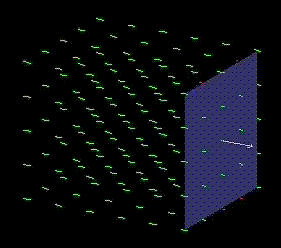|
|
|
Here was an attempt to show reflection at normal incidence to a perfect
electric conductor (represented by the blue square). |
|
|
 |
|
|
|
Notes: |
- You can make out planes of constructive and destructive
interference as the incident and reflected plane waves superimpose.
|
| |
- Keep in mind that this is just one section of an infinite set of
plane wave fields. The reflective conductor is an infinite plane
-- not a finite square as shown in the diagram. If it were
simply a square of metal, there would be very complicated diffraction
patterns as scattered waves emanate from the edges of the square in
all directions.
|
|
|